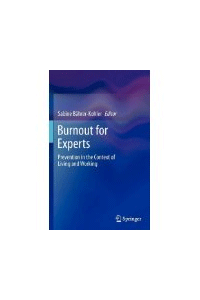“Burnout for Experts: Prevention in the Context of Living and Working”

“Burnout for Experts: Prevention in the Context of Living and Working”
By Sabine Bahrer-Kohler
Springer
New York, N.Y., 2013
Book’s global perspective is intriguing
Reviewed by James K. Luiselli, Ed.D., ABPP, BCBA-D
The term “burnout” is a generally accepted colloquialism for chronic stress, depleted energy, impaired performance and poor coping within an occupational setting. This book provides an international perspective on burnout, with chapters written by professionals from Germany, Italy, Switzerland, Spain and Brazil, among other countries. Acknowledging the complexity of the topic, the editor notes that “it is clear that burnout is a near-global, dynamic issue that has numerous facets and is not always presented uniformly, not even in this book.”
Indeed, the concept of burnout, its manifestation and how to treat and prevent symptoms are addressed differently by chapter authors. However, the book shows that there are consensus opinions about several matters. For example, burnout is strongly correlated with serious health problems, depression, emotional exhaustion, impaired self esteem and interpersonal conflict. Various chapters in the book consider these afflictions and the ancillary costs, both personal and financial, which challenge organizations.
Another focus of the book is explaining the causes of burnout. The experts seem to agree that etiology stems from the interactive process of individual (person-specific) characteristics and contextual factors within occupational environments. Both acute and enduring influences “on the job” are apparent, including but not limited to employment uncertainty, excessive workload, low job satisfaction, time pressures and lack of autonomy.
The topic of burnout prevention and treatment is also a dominant theme in the book. Here, the authors vary widely, some offering relatively simple recommendations and others presenting integrated-stage models of questionable validity. Many of the chapters reference peer-reviewed publications that support some of the proposed intervention strategies. Unfortunately, other suggested approaches have less convincing empirical support.
Finally, several of the chapter authors trace the origins and evolution of the term burnout within the historical literature, leading to contemporary definitions that are not uniformly accepted. Whether or not burnout should be labeled as a formal psychiatric disorder is, as yet, uncertain but as the book illustrates, a question of ongoing debate.
Although there is some unevenness to the book and despite the misleading title (do not infer that experts should seek burnout!), I found it to be an informative resource that has much to offer. The global perspective by itself is intriguing, taking into account divergent cultural interpretations and determinants of burnout. The book also examines assessment methods, risk analysis and categorical systems for classifying burnout as an occupational phenomenon in need of greater research attention. Many mental health professionals, particularly within organizational psychology, vocational counseling and executive coaching, should add this book to their reading list.
James K. Luiselli, Ed.D., ABPP, BCBA-D, is senior vice president, applied research, clinical training and peer review at the May Institute in Norwood, Mass.
Learn more about the book: Burnout for Experts: Prevention in the Context of Living and Working
